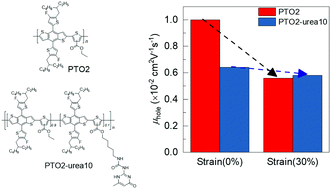Effects of stretching on the molecular packing structure of conjugated polymers with hydrogen bonding†
Abstract
We synthesized thienyl-benzodithiophene and ester-substituted thiophene-based conjugated donor polymers (PTO2-urea series) functionalized with a urea group at the terminus of the side chain. When stretched, the prepared polymer film, PTO2-urea10, in which 10 mol% of monomers constituting the polymer are the urea-functionalized monomers, showed increased crystallinity in the in-plane direction of the film. In contrast, the unmodified PTO2 polymer exhibited anisotropic reorientation of polymer crystallites in the same direction. Experiments showed that stretching-induced temporary molecular alignment in the amorphous region of PTO2 recovered to the initial state when the applied strain was removed. In contrast, hydrogen bonding between the urea groups of the polymer alkyl chains effectively maintained the organized polymer packing structures which were induced under applied strain. As a result, whereas a PTO2-based thin film transistor (TFT) device showed a dramatic decrease in hole mobility from 1.0 × 10−2 to 5.6 × 10−3 cm2 V−1 s−1 because of morphological damage and cracking of the PTO2 film, the device with a PTO2-urea10 film maintained a relatively high TFT mobility of 5.8 × 10−3 cm2 V−1 s−1 in the direction perpendicular to the strain direction because of the increased crystallinity of the polymer.



 Please wait while we load your content...
Please wait while we load your content...